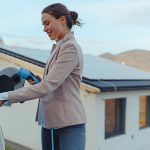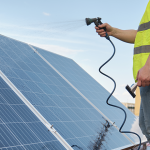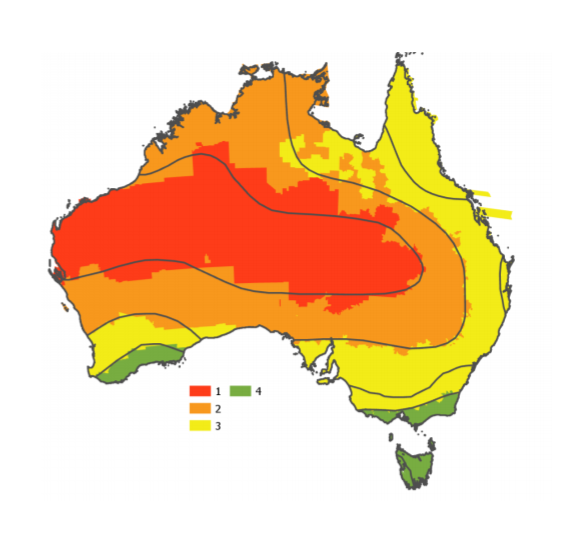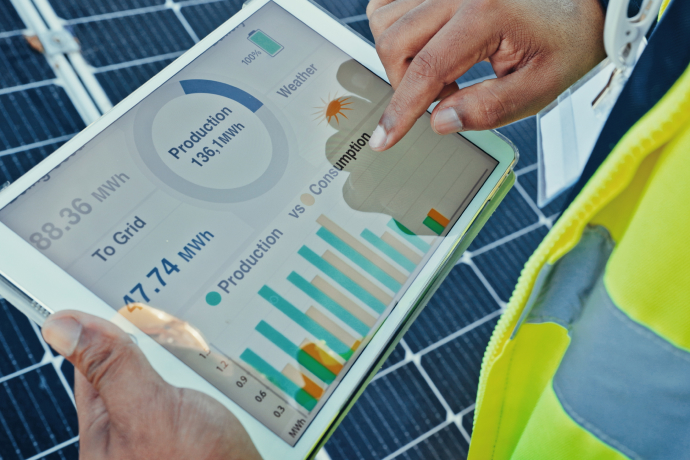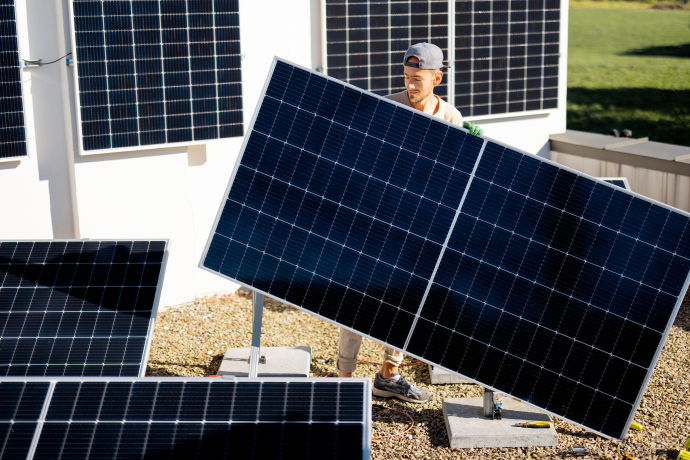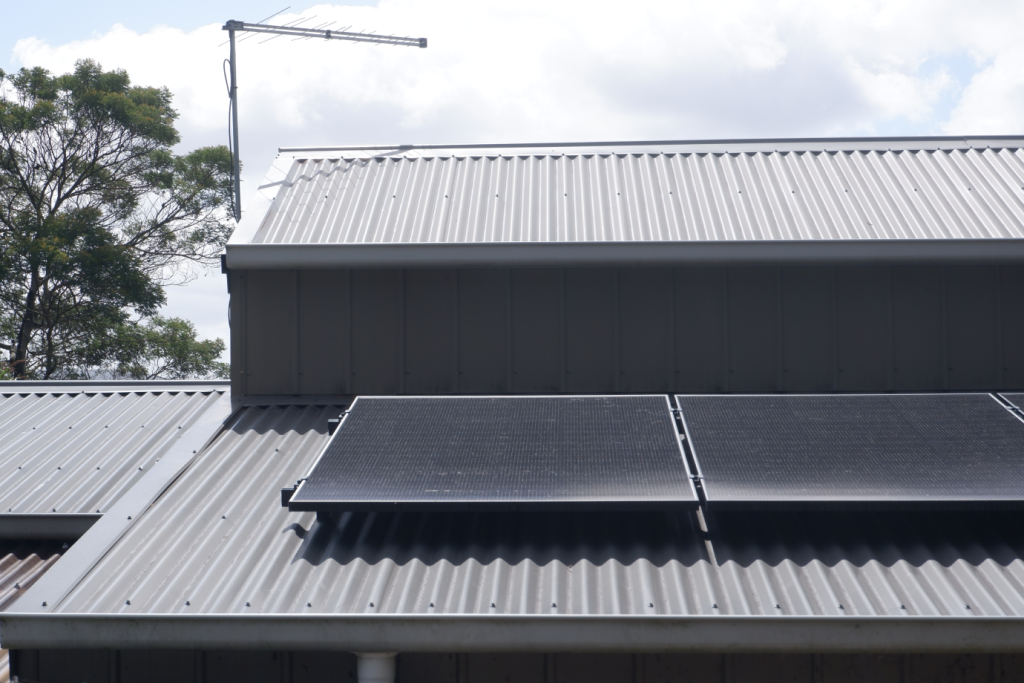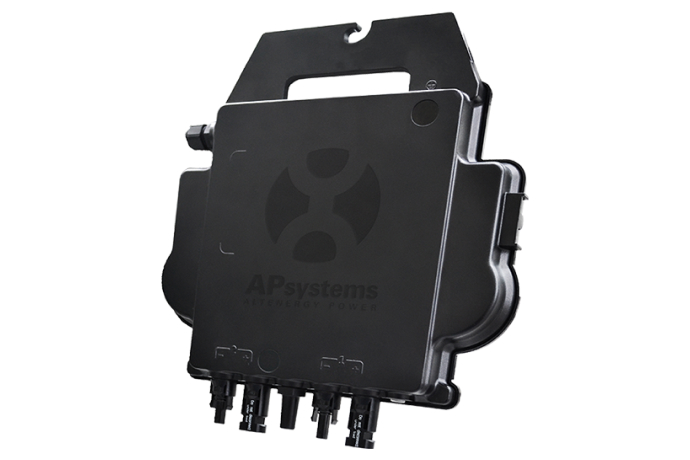Tasmania has pioneered renewable energy generation, with 100% of the island states’ electricity being sourced from renewables and over 44,700 Tasmanian homes and businesses already sporting solar panels. With this milestone achieved, the Tasmanian Government and citizens turn their eyes towards new ambitions, aiming for a 200% renewable target by 2040 and net zero emissions by 2030, according to the Clean Energy Australia 2023 Report.
Solar panels continue to fit the bill across Australia as well, with the ever-improving technology offering competitive prices for quality products. Solar energy continues to climb the renewable ranks, with Clean Energy Council Chief Executive Kane Thornton reporting an average of “six panels per minute” installed in Australia in 2018. These figures continue to climb, with OpenNEM reporting increased contributions from small-scale solar, wind and large-scale solar combining for an average share of 38.4 per cent renewable energy Australia-wide for the 12 months leading up to January 2024.
With the increased interest and development of renewables within Tasmania and across Australia, you may now be considering the viability of a solar PV system for your own home. Through the support of solar rebates, tailored solar panel systems, quality products and well-planned installations, a solar PV system will be a profitable investment for returns and property value maximisation.
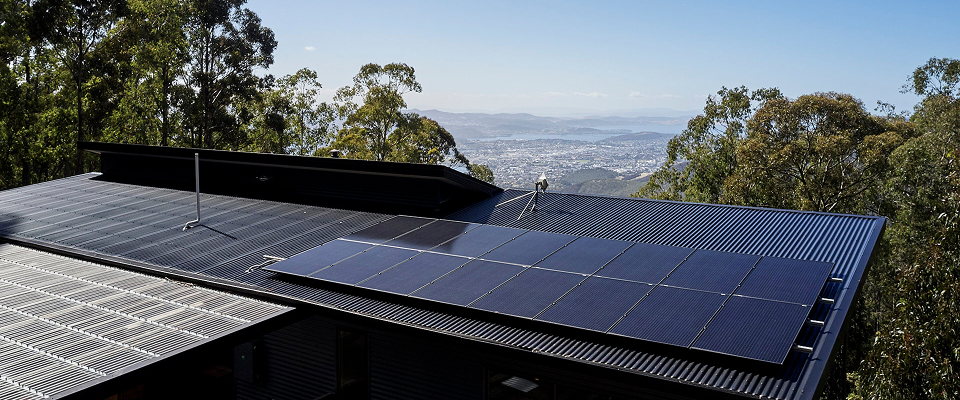
IS SOLAR POWER WORTH IT TASMANIA
At first glance, solar power in Tasmania may seem an odd decision due to the notably chilly conditions of this beautiful island state; however, a study published in the American Chemical Society journal Environmental & Technology begs to differ. Lead author Kotaro Kawajiri’s research shows that “some of the world’s coldest places, including Antarctica, have the potential for generating massive amounts of solar electricity.” Increased energy production during summer is due to increased hours of sunlight, not increased heat, with higher temperatures linked to reduced solar generation efficiency. Sunlight is the key, not necessarily temperature. So, if you’re rugged up in 3-degree weather, don’t write solar off!
The compulsory requirement for independent solar installation inspections has an added impact on the Tasmanian solar energy market. These inspections increase the price of solar energy in Tasmania but ensure a higher quality of the solar panel system’s installation and subsequent performance. Comparatively, other states’ solar energy system installers may instead choose their own inspectors, resulting in bias and reduced effectiveness.
With these two contributors addressed, the decision to adopt solar energy as a household solution is an easy one, as reflected in the Tasmanian Government Economic Regulator 2023 Report which shows a fall in electricity consumption and a continuation of the growth in rooftop solar installations. A 10.2 per cent increase in the number of solar installations and an increase in the average generating capacity was recorded for the period 2022-2023.
The medium-usage customer consumes 7,428KWh per year on Tariff 31 & 41, with an average bill of $2,064/year. With this figure in mind, estimated annual electricity savings in Hobart and Tasmania total $1032 – $1444 when considering a 4 kW – 15kW solar power system. These figures are calculated with a minimum of 50% to 70% solar energy consumption (without batteries). Energy consumption refers to the usage of solar-generated energy before using grid-generated power. So, for the average Tasmanian household with a 6.6 kW system and 60% solar energy consumption, you can expect estimated returns of around $1,238 per annum or a projected $30,960 over a 25-year lifetime.
Return on investment (ROI) on solar panel systems seems pretty clear-cut with the above numbers. However, various other factors include STC rebates, system payback periods, and, minorly, feed-in tariffs.
How fast you pay back your system is entirely dependent on your energy consumption, choice of the solar panel system and subsequent pricing. All the decisions you make before installation will be the most critical in determining your ROI.
As of July 1, 2023, feed-in tariffs in Tasmania offer a minimum of 10.869 cents per kWh on any electricity left unused and returned to the grid. Due to increased wholesale electricity prices, this rate is 22.4% higher than the 2022-23 rate.
However, you would still save 2-3 times more money consuming the electricity you produce from solar, rather than selling it back to your electricity provider as a feed-in tariff.
SELECTING A SOLAR SYSTEM FOR TASMANIA
Selecting the right solar power system is extremely important in influencing your investment returns. Many different factors influence what might be your best option. The angle, orientation, size, shading, and height of your roof, as well as your current and future annual energy consumption, are typically the most important things to take into account when reviewing solar power systems.
Analysing, reviewing and designing a solution with all those factors in mind is one of, if not the most essential, roles of your solar consultant and installer. If you’re looking to find someone to help in this, being Tassie’s number #1 local solar team since 2014, we might be able to help.
The most common systems provided by solar energy installers for residential solutions are 5kw, 6kw, 6.6kw and 10kw systems. When installed in South Hobart, these systems can offer an average daily output of 17.5kWh, 18.46kWh, 23.1kWh and 35kWh of power, respectively. These figures are well compared to the average 24.4kWh daily usage in most South Hobart homes. Initial system costs can vary greatly depending on the overall size, with a well-suited 6.6kW system in Tasmania totalling around $5,000 to $10,000. However, at a maximum system cost, payback estimates range from 4 years to 5 years, making solar system installation a profitable investment on all fronts.
If your energy consumption is higher, it stands to reason that your original investment in solar will be, too; however, due diligence should be given to solar system prices when comparing system manufacturers and installers. As we all know, if it’s cheap to buy, it is probably very cheap to make. While inexpensive solar installation solutions may be tempting, it’s best to do your research and focus on specifications. Solar energy is an investment, and while it’s certainly not as long as a mortgage, investing in a higher-quality installation can give greater returns in the long run. Inadequate installation of a solar system can, at best, substantially reduce your energy generation and, therefore, negatively impact your ROI. At worst, an inadequate installation could cause electrical fires, damaging your home and family.
Additionally, lower-quality or ‘cheap’ solar panels will have consequences due to poor manufacturing; it’s crucial to ensure a comprehensive product manufacturer warranty on any systems you consider. The standard rule-of-thumb is a 10-year solar panel product warranty with 5+ years on the inverter. Crafty solar salespeople will draw your focus to 25-year panel warranties. Be aware this is NOT a product warranty; it’s the panel performance warranty.
Warranties are a significant aspect to keep in mind when purchasing solar panels. There are actually 4 separate warranties with a standard solar system (Installation, Product, Performance and Inverter), more if you buy a battery or other solar peripherals. Check out this ‘Guide to Solar’.
SOLAR REBATES AUSTRALIA
The STC program, otherwise known as the Small-scale Technology Certificate program, offers generous reductions in prices Australia-wide. As a Zone 4 qualifier, Tasmanian residents are eligible to receive STCs valued at $2,080 for a 6.6kW solar system. Overall, STCs automatically discount solar energy systems by roughly 20 – 30 per cent, offering high incentives for any and all takers. Policy and Research Manager at sustainability advocacy group Renew, Damien Moyse, states that “someone basically spending $7500 to get back $1500 annually is a great deal” Mr Moyse goes on to compare solar energy to mortgage repayments, with solar energy systems providing a 20% return on investment in the worst-case scenario. The overall STC return can range from $473 to $31,521 on 1.5kW to 100kW systems, respectively, in Tasmania.
STC zoning for solar panel installations is determined by your postcode, with traditionally warmer areas having higher solar radiation levels.
Despite the variation in government rebates and support, the positive statistical returns remain the same, with solar energy firmly established as a low-risk investment with a high pay-off. With solar panels at their most affordable prices yet, the significant discount offered by the federal government places solar systems in Tasmania at bargain prices for clean, reliable energy. Government rebates and subsidies will continue to scale down with higher adoption, moving us towards our renewable energy targets, so these offers are something you don’t want to hit the snooze button on.
AFFORDABLE SOLAR TASMANIA
If we were to look ten years ago, 1kW of solar panels would set you back around $10,000. That kind of money can now find you installing around 22-27 panels, generating 6-10kW of energy. So it’s safe to say that solar is a lot more affordable now than it has ever been.
Solar power compares extremely favourably against buying power directly from the grid; however, the math is a little less straightforward. Assuming you outright purchased a new solar power system, it would take 4 to 5 years to make your money back (power bill savings versus the amount spent on purchasing the solar power system). This is called the payback period.
So, at first glance, it would seem like you would be out of pocket. But, as with any investment, it is a matter of time.
After the payback period, any additional time spent generating power with your solar panel system is pure profit. Considering a typical residential solar system has an average lifespan of 20-30 years, a well-utilised solar system is one of the best investments you can make in your home. And most certainly a lot more affordable than buying power directly from the grid.
Tasmania has the highest reported self-consumption figures in the country, with Hobart reporting 30% average self-consumption for 6.6 kW systems. Tasmania also offers the potential for larger systems than mainland installations, allowing for greater energy production and subsequent returns.

Another draw for solar power investments is the feed-in tariffs. Feed-in tariffs offer financial returns on unused power by essentially feeding it back into the grid, and Tamania has some of the highest feed-in tariff rates in the country. The minimum feed-in tariff in Tasmania is 10.869 per kWh, but the maximum depends on your energy retailer. Tasmania has four major energy retailers, with Aurora Energy originally cornering the market until 2019. These four major retailers are Aurora Energy, 1st Energy, Energy Locals and Future X Power. Presently 1st Energy provides the most competitive rates through their 1st Solar Bonus Plan, putting their maximum rate at 12 cents per kWh.
In comparison, feed-in tariff minimums around Australia roughly total as follows:
- VIC: 4.9 cents per kilowatt-hour
- NT: 9.13 cents per kilowatt-hour
- WA: 10 cents per kilowatt-hour
- ACT: 8 cents per kilowatt-hour
- NSW: 7.7 cents per kilowatt-hour
- SA: Currently, there is no minimum feed-in tariff rate in South Australia. Electricity retailers set their own rates as Voluntary Retailer Contributions. These include feed-in tariff rates from 1 cent to 12 cents per kilowatt-hour.
- QLD: Also subject to Voluntary Retailer Contributions, QLD includes rates from 1 cent to 15 cents per kilowatt-hour.
Feed-in tariffs, however, are not the primary indicator for investment returns, with greater returns on consumed energy over sold energy.
MAXIMISING YOUR EFFICIENCY
The major determining factors in maximising your solar system’s efficiency are decided before you spend your first dollar on solar. At a glance, homeowners can achieve power maximisation through:
- Well-positioned panels
- Proper panel and inverter selection, tailored for your home’s unique circumstances
- Regular maintenance and cleaning
- Scheduled power usage to maximise self-consumption
Your solar system’s performance will depend strongly on your system solution and installation process, so choosing a reliable and experienced installation specialist is vital in addressing any potential issues.
The position of your solar panels in Tasmania can make or break the efficiency of your system. By facing your solar panels correctly, you can improve the amount of light they receive daily. As a general rule, systems installed in South Hobart should face north for optimal solar energy generation, with an angle of 26 to 37 degrees. Similarly, Launceston installations are best positioned at a north-facing installation of 26 to 36 degrees. It’s just common sense that having your solar panels facing the sunnier side of your home will provide optimal energy generation. If faced with the decision to install your setup either east or west, there is a considerable difference in energy production, with both Hobart and Launceston installations favouring eastern setups. Output percentages for east-facing systems average 90% production instead of a lower 80 – 82% when facing west.
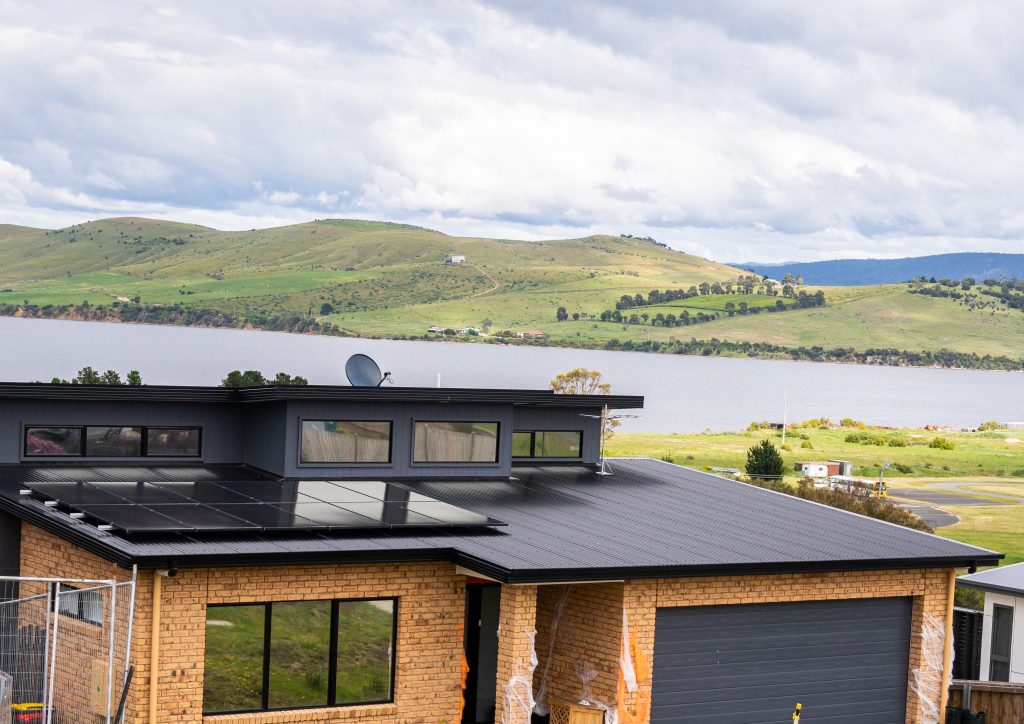
However, it’s important to consider lifestyle factors such as when you’re more likely to get use out of your system. If you have a west-facing system, you will produce more power in the afternoon versus east-facing systems for the morning. This difference in energy production can prove beneficial for different living habits and work schedules as you may wish to use energy at different times of the day. Long story short, if you’re an early bird who likes to enjoy their cuppa in a toasty warm kitchen, an east-facing system is the go. Alternatively, west-facing panels are perfect for those who prefer to get their laundry and washing done in the afternoon hours of the day!
On the less desirable end of the spectrum, we have south-facing panels; purchasers should avoid these at all costs due to the geographical location of Tasmania causing these installations to produce two-thirds of the energy produced by north-facing panels annually. South facing installations will have you crawling your way to the finish line. Regardless of positioning, panel installations should always allow for sufficient spacing to ensure that the panels do not overheat, as this can affect the overall panel efficiency.
Once you have the direction, orientation and lifestyle factors accounted for, TSS delves into some of the other major variables that start to determine the types of panels and inverters you should use to maximise your solar production efficacy, including:
- Harsh weather conditions: TSS prides itself in safe and weather-resistant installations, with all of our standard systems requiring the use of stormproof mounting systems, which are designed with high-quality end caps to ensure your system is bolstered against various environmental conditions such as extreme heat, wind, storms and hail
- Limited roof space: Limited roof space can significantly impact the output of your solar system due to the reduction of panel space available. TSS can remedy this by installing higher efficiency panels that boast conversion rates of up to 23% as opposed to standard panels that max at around 18%. This means that solar system owners can maximise the output of their limited roof space.
- Shaded roof: Having a large amount of shade on your roof can affect the ability of your solar panels to absorb the sun’s rays and produce solar power. TSS offers micro-inverters as a solution to this issue, which vastly changes the systems output levels when paired with AC panels. This is due to micro-inverters utilising an alternative output system to conventional inverters. Conventional inverters run in a string array, meaning issues such as shade or debris on one panel feed down through the system, reducing the output of each panel to match the initial reduced panel’s production. Comparatively, a micro-inverter separates each panel’s output and isolates their production to their respective performance, meaning that if a panel is shaded, it will not negatively impact any of the other installed panels.

There are also factors you can control after the installation and design of your solar system is complete.
By planning the timing of things such as washing machine and dishwasher usage, you can ensure better self-consumption in line with your system’s energy generation. You can also line up things such as heating or cooling your house with these solar generation windows to prevent the need to use tariffed electricity later in the day. Scheduling energy usage is easier when using a monitoring application to monitor your daily usage and the amount of power your system is generating. These applications are generally included with systems and can vary in mobile or inbuilt support. Additionally, some household appliances and systems such as dishwashers, heating systems and pool filtration systems will allow for scheduled operation using timers to take the micro-managing out of energy management. Like a household budget, electricity is something you need to regularly balance and monitor to get the most out of it.
Following initial installation placement, it’s essential to maximise your system through regular maintenance and cleaning. Just like a dirty mirror won’t show you the prettiest picture, grubby panels will not deliver the best returns. A clean and well-maintained panel allows for the best energy generation possible, with professional cleaning recommended twice a year, resulting in 3 to 5% increased energy efficiency. If you’re the more hands-on type, you can also consider cleaning your panels using a soft sponge and water, being mindful not to include any abrasive soaps or harsh materials as this may damage your system. However, cleaning your own solar system is generally not recommended as it can be dangerous due to hazards such as falling from your rooftop—best leave falling off roofs to the professionals.
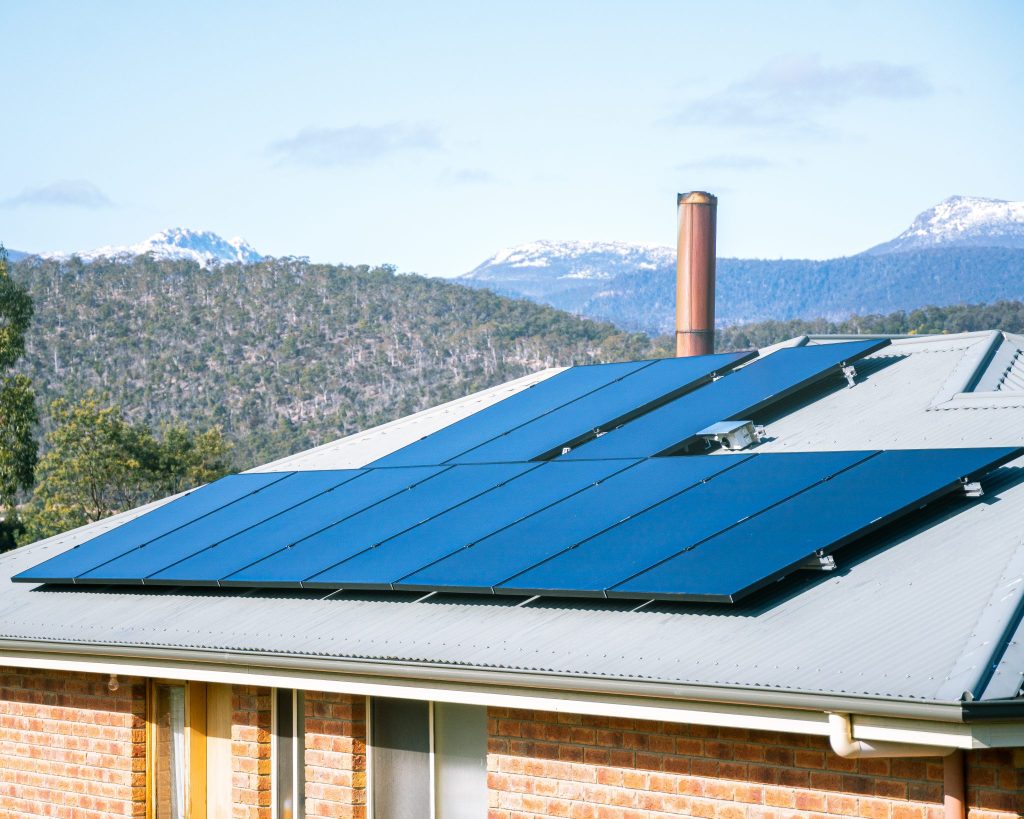
To ensure that your system is maintained correctly, TSS recommends yearly inspection and maintenance by a solar professional. The maximum time you should leave between professional maintenance is five years, as seemingly minor issues can compound and severely reduce the performance of your system. Regular maintenance will maximise not only your system output but also the lifespan of your panels and inverters. TSS technicians can diagnose and repair any issues, check the condition of the wiring and electrical components and ensure that all parts are free of debris.
Other additions you may want to consider are solar batteries. These batteries allow you to store excess generated energy rather than put it into feed-in tariffs. System owners can then use this extra energy at night to supplement what you can’t generate or for unexpected grid outages, giving you a more self-sufficient system. A solar battery allows you greater energy independence and security.
Overall, investing in solar is a permanent investment in your home, proven to increase the value of your home and provide substantial financial savings. It’s essential when considering a solar system to plan for the future to maximise your system according to your lifestyle goals. A solar system’s efficiency needs to be designed to accommodate later possibilities in life, such as having children and property developments. Planning your solar system installation around these things with the TSS will allow you to prepare for increases in energy usage and roof space.
INCREASE YOUR PROPERTY VALUE WITH SOLAR
Solar energy systems offer great returns on investment, with various options such as self generating electricity, feed-in tariffs and solar specific government rebates, meaning that homeowners now have more control than ever over their energy consumption. However, the benefits of solar energy don’t stop there. Not only does this investment benefit families looking to cut back on their ever-growing energy bills, but it also adds value to your property.
With the Australian property market consistently booming since the mid-1990s, homeowners continue to invest in the development and increased valuation of their assets. As it stands, the median price of property in Hobart totals at a whopping $860,000 and the Launceston market sees houses priced at about $653,000. These prices continue to grow on top of these rates, from investment in residential solar energy systems, as purchasers and renters show increasing favour towards sustainable energy solutions.
A 2018 survey of 1,005 Australians from ages 18 to 79 showed that 77% of Australians prefer renewables, leaning towards properties with solar systems. No matter the age, no one can deny a good deal. Overall research shows that solar panel installations can increase the value of a home to $6000 per kilowatt, with 5kW systems having the potential for a $29,000 increase to home values and a 20% increase in selling speed.
There may be those that are unhappy with the cosmetics of solar panels, despite the significant financial benefit. For those people, we provide options such as black slim line panels or integrated solar panels that significantly improve the aesthetic of solar panels on your home’s roof. Due to their designer aesthetic, they provide an even higher increase to property value.
OFF-GRID SOLAR TASMANIA
There are some that may be considering an off-grid set-up, aiming for total energy independence. Generally, off-grid systems are considered by people wanting complete control over their energy costs or those located further out in the countryside. These ambitious setups can total north of $26,000, including 5wH panels, 40kWh batteries, and a diesel generator for emergency power outages. These systems can take up to 19 years to pay off with net savings of $1,000 per year when deducting annual maintenance and diesel costs.
After the initial pay off period, battery lifespans generally total at around 5 to 15 years, which means an additional $12,000 required to replace 40kwH batteries at the 15-year maximum mark. Off-grid systems require consideration given to power consumption, budget, available space and renewable alternatives, but ultimately entirely off the grid solar can be a hefty undertaking and should be approached with caution in terms of feasibility.

